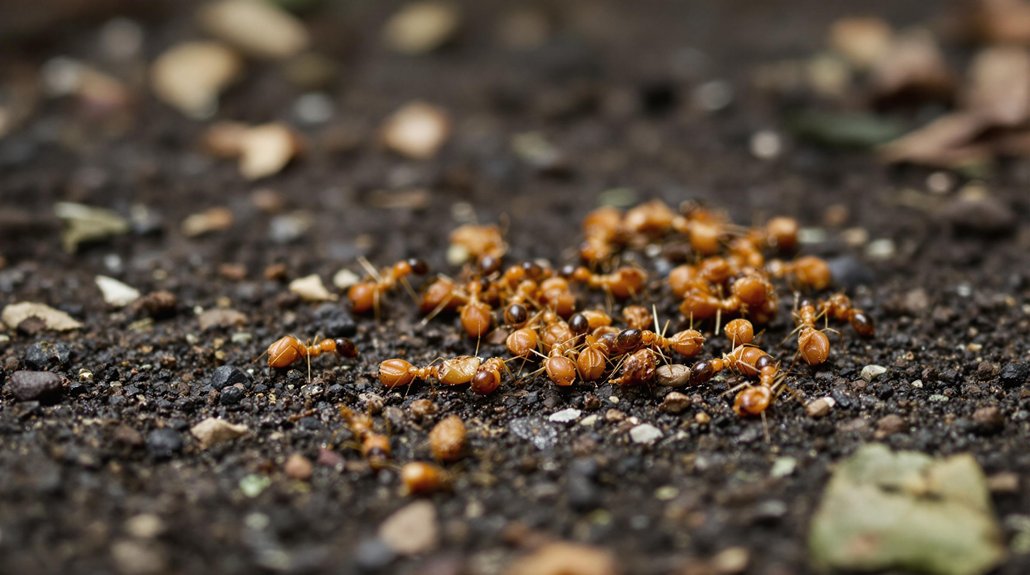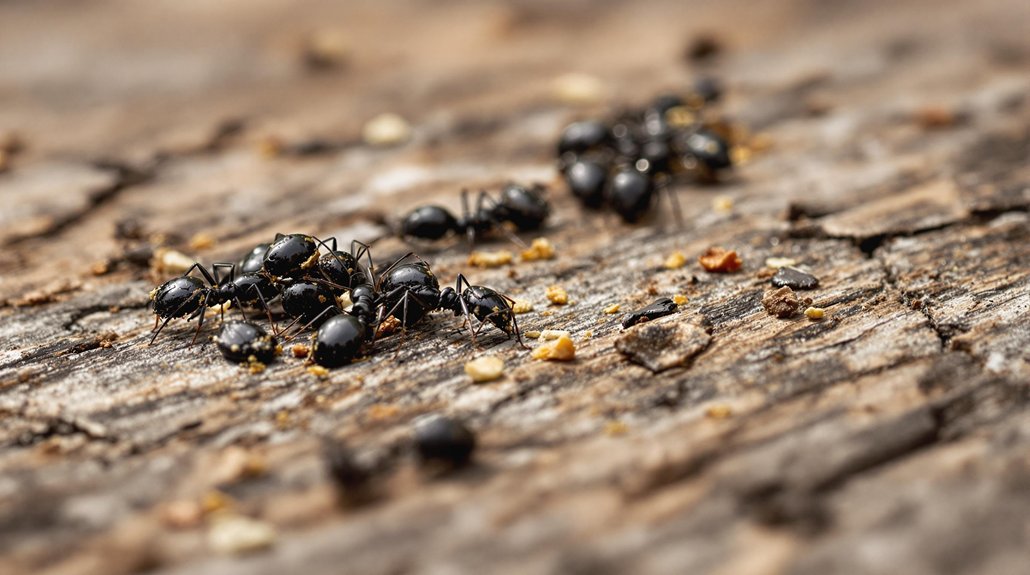Leaving dead ants around can influence nearby ant activity, but whether it attracts more depends on various factors. Dead ants may emit chemical signals that alert others or trigger scavenging behavior. However, some dead insects might actually repel ants or not have a strong enough scent to attract more. The response varies based on the type of ant and how decomposed the dead insect is. If you want to understand how this works and what you can do, there’s more to explore.
Key Article Highlights
- Dead ants emit chemical signals that can either attract scavengers or repel other ants, depending on their decomposition stage.
- Fresh dead ants may release scent cues that attract ants seeking food or nutrients.
- Decayed or decomposed ants often emit signals that deter or have no effect on nearby ants.
- The presence of dead ants can trigger scavenging behavior but does not necessarily lead to increased ant infestation.
- Proper disposal of dead ants prevents potential chemical cues that might attract more ants or pests.
The Science Behind Ant Attraction to Dead Insects

Ants are often seen gathering around dead insects, but why do they do this? It all comes down to their behavior and how they respond to insect decomposition. When an insect dies, it releases specific chemicals, like fatty acids and other signals, that ants recognize. These chemical cues alert ants to the presence of nutrients and potential food sources. Their ability to detect these signals shows their keen sense of smell and their role as scavengers. Ant behavior is driven by survival instincts, so they quickly locate and exploit dead insects for nourishment. This natural response helps them efficiently recycle nutrients back into their colony. Understanding this process highlights how ants play an essential part in the ecosystem by cleaning up decaying organic matter.
How Ant Colonies Detect Food Sources
Ant colonies find food using a few key methods. They leave behind scent trails called pheromones to guide others, and communicate in different ways while foraging. Their ability to detect food relies on these signals and their sense of smell.
Pheromone Trail Signaling
Pheromone trail signaling is a key method that colonies use to find food. Ants release ant pheromones to create scent communication pathways that others can follow. When a forager finds a food source, it leaves a trail of pheromones on its way back to the nest. This trail acts as a guide for other ants, helping them locate the food efficiently. The strength of the pheromone scent indicates the trail’s popularity, encouraging more ants to follow it. Over time, the trail may fade if not reinforced or if food sources are depleted. This system allows colonies to adapt quickly, focusing their efforts on rich food sources while ignoring less promising ones. Overall, pheromone trail signaling is essential for effective foraging and colony coordination.
Foraging Communication Methods
Colony members use a variety of methods to find food beyond just following scent trails. Ant foraging relies on diverse communication signals that help workers locate resources efficiently. Some ants use visual cues, like movement or changes in the environment, to detect food sources nearby. Others rely on tactile signals, including touching and antennation, to share information about food locations. Chemical communication remains essential, with ants releasing specific signals that inform others about food presence or safety. These methods work together to coordinate the foraging process, making the colony more effective at resource collection. Understanding these communication signals provides insight into how ants optimize their foraging strategies without solely depending on pheromone trails, highlighting the complexity and adaptability of their social behavior.
Ants’ Food Detection Techniques
Beyond communication signals, ants have developed a variety of ways to detect food sources directly. They use their antennae to sense chemical cues in the environment, which helps them locate nearby food. When ants encounter a potential food source, they pick up specific odors that alert others through ant communication, creating a trail for the colony. Additionally, ants can detect the taste and smell of food through their antennae and mouthparts. These sensory methods allow them to efficiently find and evaluate food sources without relying solely on pheromone trails. Their ability to directly sense chemicals in their surroundings is essential for foraging success. Overall, ants’ food detection techniques combine chemical sensing with communication, making their foraging highly effective.
The Role of Pheromones in Ant Behavior
Pheromones help ants communicate important messages, like warning of danger or marking a trail. Dead ants release scents that can influence the behavior of others nearby. These chemical signals are key to how ants find food and stay safe.
Pheromones Signal Danger
Ants use chemical signals called pheromones to warn each other about danger. This kind of pheromone communication is key to understanding ant behavior during threats. When an ant detects a threat, it releases specific pheromones that alert nearby ants to the danger. These signals cause a quick change in behavior, prompting others to retreat, defend, or flee. The table below shows different pheromones and their signals:
| Pheromone Type | Signal | Effect |
|---|---|---|
| Alarm pheromones | Warning of predator attack | Increased alertness |
| Trail pheromones | Food or danger path | Guides others to or away |
| Distress pheromones | Injury or threat signals | Triggers defensive actions |
This system helps ant colonies coordinate responses efficiently, highlighting how pheromone communication guides ant behavior in dangerous situations.
Dead Ants Emit Scent
When an ant dies, it often releases specific chemical signals that can influence the behavior of nearby ants. This ant scent acts as a dead signal, alerting others to danger or the presence of a fallen comrade. The dead signal is part of how ants communicate about threats and resource locations. These chemical cues are detected through specialized receptors, prompting behaviors like avoiding the carcass or increasing alarm responses. The scent of a dead ant can linger, making it a significant cue in colony dynamics. Understanding this dead signal helps explain why ants sometimes gather around dead bodies or become more cautious nearby. Overall, the ant scent emitted by dead ants plays a key role in colony safety and response to threats.
Trail Reestablishment Mechanisms
After a foraging trail is disrupted, whether by a predator or environmental change, the colony needs a way to quickly mark and find the new path again. Ants use trail reestablishment mechanisms involving pheromones for efficient ant recruitment. When an ant finds food or a new route, it deposits pheromones on the ground, creating a chemical trail. This trail signals other ants to follow and reinforce the path, making it stronger over time. If the trail is broken or dead ants are present, the scent diminishes, and fewer ants are recruited. Understanding this process helps explain how colonies adapt swiftly to changes and maintain efficient foraging. The table below shows how pheromone signals support trail reestablishment and ant recruitment:
| Step | Description |
|---|---|
| 1 | Discovery of a new route |
| 2 | Ant deposits pheromones on the trail |
| 3 | Pheromone trail attracts more ants |
| 4 | Ants reinforce the scent |
| 5 | Trail becomes strong and well-used |
Do Dead Ants Emit Signals That Draw Others?

It’s a common question among nature enthusiasts: do dead ants produce signals that attract others? Insect communication often relies on chemical signals called pheromones, which help ants coordinate activities like foraging and defense. When an ant dies, its body begins insect decomposition, releasing chemicals into the environment. Some researchers believe that these decomposition signals might mimic or trigger ant communication pathways, potentially drawing other ants to the site. However, evidence is mixed. While live ants respond strongly to alarm or trail pheromones, dead ants typically do not emit specific signals meant to attract others. Instead, their presence may simply be a cue for scavenging or alerting ants to a potential food source, but they do not actively broadcast signals to attract colonies.
Factors That Influence Whether Dead Ants Attract More
Several factors can influence whether dead ants attract other ants or not. One key aspect is ant behavior, which varies among species and colony states, affecting their response to dead insects. The stage of insect decomposition also plays a role; fresh carcasses may emit different chemical signals compared to those in advanced decay, impacting attraction levels. Environmental conditions, such as temperature and humidity, influence insect decomposition rates and scent dispersal, altering how effectively dead ants attract others. Additionally, the presence of certain chemical cues, like alarm pheromones released during decomposition, may either lure or repel ants. Overall, these factors combine to determine whether a dead ant acts as an attractant, making the response highly context-dependent and tied closely to insect decomposition processes and ant behavior patterns.
Common Myths About Ants and Dead Insects
Many people believe that dead ants always attract large numbers of other ants, but this isn’t necessarily true. This is a common ant misconception that stems from misunderstandings about insect behavior. In reality, not all dead insects, including ants, send strong signals to others. Some believe that the smell of dead ants draws more, but many factors influence this, like scent strength or the presence of pathogens.
- Dead ants may sometimes repel scavengers rather than attract more ants.
- Not all ants detect or respond to dead insects in the same way.
- Insect behavior varies widely; assumptions about dead ants attracting more often are oversimplified.
Understanding these myths helps clarify how ants and insects actually behave, which is key for better management and control.
Effective Strategies to Manage Ant Infestations

Managing ant infestations effectively requires a combination of strategies tailored to target colonies and prevent future invasions. The key is combining ant control methods with natural repellents to keep ants away. First, identify and seal entry points to block access. Second, keep your space clean—food scraps attract ants. Third, use natural repellents like vinegar, peppermint oil, or citrus to deter ants naturally. The table below summarizes some common approaches:
| Strategy | Description | Effectiveness |
|---|---|---|
| Sealing Entry Points | Block cracks and gaps | High |
| Cleanliness | Remove food and water sources | Very high |
| Natural Repellents | Use essential oils or vinegar | Moderate |
| Regular Monitoring | Check for new ant trails | Essential for control |
These steps help in mastering ant control naturally and efficiently.
Preventing Unintentional Attraction of Ants to Dead Insects
Keeping your space clean not only helps prevent ant invasions but also reduces the chances of attracting ants to dead insects. Proper insect disposal is key to effective ant prevention. When insects are left lying around, they can send signals to ants that food or resources are nearby. To avoid unintentional attraction, always remove dead insects promptly and dispose of them properly. Regular cleaning of surfaces and trash areas minimizes scent trails that attract ants. Additionally, sealing cracks and entry points prevents ants from accessing areas where dead insects might pile up. Maintaining a tidy environment disrupts ant pathways and discourages foraging. By staying vigilant with insect disposal and cleanliness, homeowners can keep ants from being lured by dead insects and improve overall ant prevention efforts.
- Dispose of dead insects immediately and securely
- Keep trash cans sealed and clean
- Seal cracks and entry points to limit access





